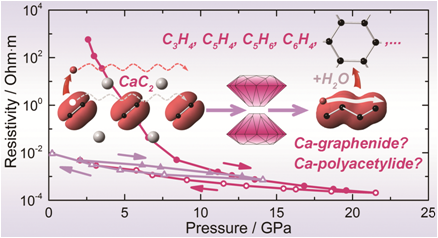Pressure induced Polymerization and metaliztion of CaC2 - Drs. Haiyan Zheng & Kuo Li
AUGUST 30, 2016
Transformation between different types of carbon–carbon bonding in carbides often results in dramatic changes of physical and chemical properties. New work from a team led by scientists from HPSTAR, Drs. Haiyan Zheng and Kuo Li has given a systematical investigation on CaC2 under external pressure from multiple techniques and found linear C22- will polymerize into cyclic C66- structure, accompanying with more than 107 folds enhancement in the conductivity. The journal Chemical Science (DOI: 10.1039/c6sc02830f) has published an article featuring the results of the study.
CaC2 is the most important and common metal carbide used in industry. Its polymorphs have been investigated for almost a century, and new questions keep arising. The C22- in CaC2 was predicted to transfer into 1D chain, ribbon and 2D graphene sheet at higher pressures. Experimental evidence is needed to prove these theoretical predications. However, most of the experimental researches were hindered by the amorphization due to lacking of suitable techniques to probe the amorphous phase.
 The team aim to know the detailed phase transitions in CaC2 and what is the chemical reaction covered up by the amorphization. Multiple in situ techniques including high pressure X-ray diffraction (XRD), neutron diffraction, Raman spectroscopy, IR and impedance spectra, and ex situ neutron pair distribution function (PDF), Gas Chromatography Mass Spectrometry (GC-MS) analysis, as well as meta-dynamic simulation were employed in the study.
The team aim to know the detailed phase transitions in CaC2 and what is the chemical reaction covered up by the amorphization. Multiple in situ techniques including high pressure X-ray diffraction (XRD), neutron diffraction, Raman spectroscopy, IR and impedance spectra, and ex situ neutron pair distribution function (PDF), Gas Chromatography Mass Spectrometry (GC-MS) analysis, as well as meta-dynamic simulation were employed in the study.
CaC2 become amorphous above 18 GPa from XRD, neutron, and Raman measurements. Before amorphization, no distinct peaks show up, while a distortion of CaC2-I to CaC2-VI matches the diffraction data between 10 and 12 GPa.
The scientists found C66- and tens of other polycarbide anions in the recovered amorphous sample from the following Gas Chromatography-Mass Spectrometry measurement, which is solid evidence supporting the polymerization of CaC2. The amorphous polymer contains the (fragment of) predicted chain and ribbon structures. “Our experiment evidenced that under 20 GPa and room temperature it is possible for C22- to polymerize into carbon ribbons,” said Haiyan.
Accompanying with the structural variations, the conductivity of CaC2 was enhanced by more than 107 folds, which corresponds an insulator to metal transition. “This indicates the dramatic effects of high pressure on the electrical properties of carbide materials”, added Haiyan.
The polymerization helps to stabilize the high conductivity to ambient pressure, also shows possibility to stabilize the predicted phases including calcium graphenide and calcium polyacetylide, stated in the paper. “This study point that high-pressure will be a unique technique for synthesis of functional metal-carbon materials and other novel metal polycarbide materials”, Kuo added.
Caption: Pressure induced polymerization of acetylide anions in CaC2 and 107 folds enhancement of electrical conductivity, courtesy of Haiyan Zheng.
